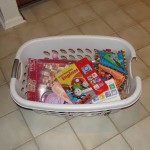I’m an avid documenter. There’s typically one of us in every family. We’re typically known as the family historian. My maternal grandmother, Virda, is a historian. She has family albums going back several generations with pictures that are actually labeled, handwritten notes, and things like the hospital bill for her first baby. I admire her a lot and credit her for giving me my love of recording facts.
Part of being the historian is being a picture-taker, or at least a picture organizer. From the time Henry and I married I’ve kept our pictures well-preserved. Most of them are in acid-free scrapbooks telling tales of our various adventures over the last 15 years.
I realize not everyone is a born historian. I also realize there are people who wish they also could tell their stories, but don’t know where to start. Here are a few tricks to getting a handle on your backlog of pictures:
1) Start with your most recent pictures and work your way backward: Starting with your oldest pictures and watching the pile getting bigger as you take more pictures can be discouraging. Instead, start with your most recent and work on your backlog as you have time.
2) Purge, Purge, Purge: Delete pictures that are blurry, unflattering or unimportant. The less you have to weed through when the time comes to put together an album the better. When working with thumbprints online or on a screen it can be difficult to tell which pose is the one with your eyes closed without spending a little bit of time flipping back and forth between files. Deleting pictures you don’t need is always useful and saves time in the long run. (The same is true with print photos)
3) Determine your personal style: When choosing how to document your adventures, decide whether you want to use store-bought picture albums, store-bought scrapbooks, online picture books, or online scrapbooking software. Knowing your comfort level upfront lets you move on to the process of getting your pictures organized.
4) Give yourself permission to make it good, but not perfect. If you have a backlog consisting of years, possibly decades of pictures, it’s important to understand your books don’t have to be the best out there. Getting your pictures organized chronologically (this can be harder with printed photographs), labeled and into a book is what’s important. Your grandkids won’t care if you used a perfectly matching scrap of paper with your grandparents’ wedding photo as much as they will knowing who’s in the picture and when it was taken. The details are always more important than aesthetics.
5) Set aside time: Once you’ve decided if you’re using online tools or paper tools or a mixture of both (one for print photos and one for digital), sorted all your photos and uploaded the ones you want to use, set aside time to make your albums. Whether you do it once a month or once a year make it your goal to complete a certain number of albums this year, even if it only means keeping up with the current year.
In our family’s case, I used scrapbooks for all our photos before Natalie’s birth (when we purchased our first digital camera) and online photo books from places like Snapfish and Shutterfly for everything after.
When I was paper-scrapbooking I had to put aside time every month to work on pages or I’d get too far behind. I still do a first-year baby book for each of my kids and had to work on them monthly to finish them. Embarrassingly enough, I’m still working on Ryan’s… or I should say…. I keep meaning to work on Ryan’s. There a lot more to document, but I’m happy to say I’m at least halfway through.
For our annual family books I take about two or three hours every year to go through the last 12 months of photos and select and upload the best ones into one online album. Then I use the site’s software for another hour or so to make the book – both Snapfish and Shutterfly (and several others) have super easy software allowing you to change layouts easily and click and drag photos into place. It may take me another hour to put captions and dates throughout the book. So in about 5 hours I can complete an entire year’s worth of photos. It’s the fastest way I’ve found to keep up with each year.
I must warn you though – the more you document the more you might want to take pictures. So when you leave the house make sure to grab your camera. You never know what fun pictures you might get in an ordinary day.

Hi! I’m Leighann. I help busy women go from frazzled to fabulous. I talk about winning imperfectly at life, finding hope in every season, and learning to manage stress while accomplishing your goals. But wait! I have two freebies below – don’t miss out on them – one to cultivate more calm in your life and the other to increase your productivity. Download them now!






